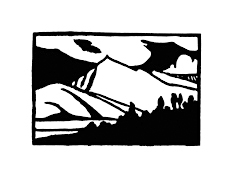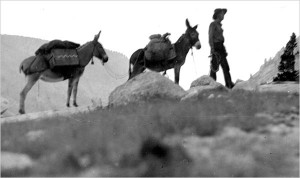There isn’t an indigenous American sadhu tradition, ascetic wanderers on the (south Asia) Indian model. But we do have, thanks to our vast open spaces, celebrated individual instances of semi-ascetic wanderers in the American West and Alaska. Jon Krakauer’s Into the Wild documented the life and death of Chris McCandless, for one, and discussed another, the poet and artist Everett Ruess (1914–1934), whose disappearance at the age of twenty added to his romantic mien the appeal of a good mystery. Others in this category include, prototypically, John Muir, Edward Abbey, and Henry Thoreau, although Thoreau was a wimp compared to, say, Dick Proenneke or Daniel Suelo — who combines Indian sadhu experience with southern Utah sliprock country, like Ruess — or the Peace Pilgrims (I & II). But it’s a category that has broad appeal, I think, and the most moving part to me of Krakauer’s book was the self-reflection (I can’t remember now if it was at the beginning or the end, but it involved a story about risky solo climbing in southern Alaska) piece in which Krakauer, like me, admitted to feeling some of what McCandless was after.
 So: Everett Ruess. He grew up in southern California and started taking long trips by himself from the age of sixteen in California and the desert southwest. He knew Ansel Adams, Dorthea Lange, and Edward Weston and wrote, painted, photographed, and made block prints, mostly of the natural world.
So: Everett Ruess. He grew up in southern California and started taking long trips by himself from the age of sixteen in California and the desert southwest. He knew Ansel Adams, Dorthea Lange, and Edward Weston and wrote, painted, photographed, and made block prints, mostly of the natural world.
David Roberts has an excellent story about the search for Ruess, who was last seen alive in Escalante, Utah in the autumn of 1934, walking out of town with two little burros and a week’s worth of food, headed for the Hole in the Rock trail. His family expected him back in two months’ time and when he didn’t return, they started searching. They found his camp the next spring in Davis Gulch, a tributary of the Escalante River near the present-day Lake Powell. His two burros were still in their pen but there was no sign of Ruess. Roberts believed (in his 1999 article) that Ruess was killed by cattle rustlers and buried in a rough grave near his camp.
But recently, in 2008, an archeologist working on a Navajo reservation excavated a grave, located 77 miles east of Ruess’s last camp, with remains that matched Ruess’s. Subsequent DNA testing with surviving family members suggested a genetic match, as well. The site was excavated based on an account of an elderly Navajo who recalled his grandfather’s story of witnessing the murder of a young white man in 1934. Roberts, the author of the previous story, revisits the case in a subsequent article, in which he concludes that the earlier accounts must be wrong — the burros weren’t really there — and that this is indeed Ruess’s last resting place.
But the story doesn’t end there: the AP and the New York Times report that the Utah state archeologist has raised doubts about the findings, particularly a mis-match between the remains and Ruess’s known dental records.
So Everett, like so many others, may still be out there.


